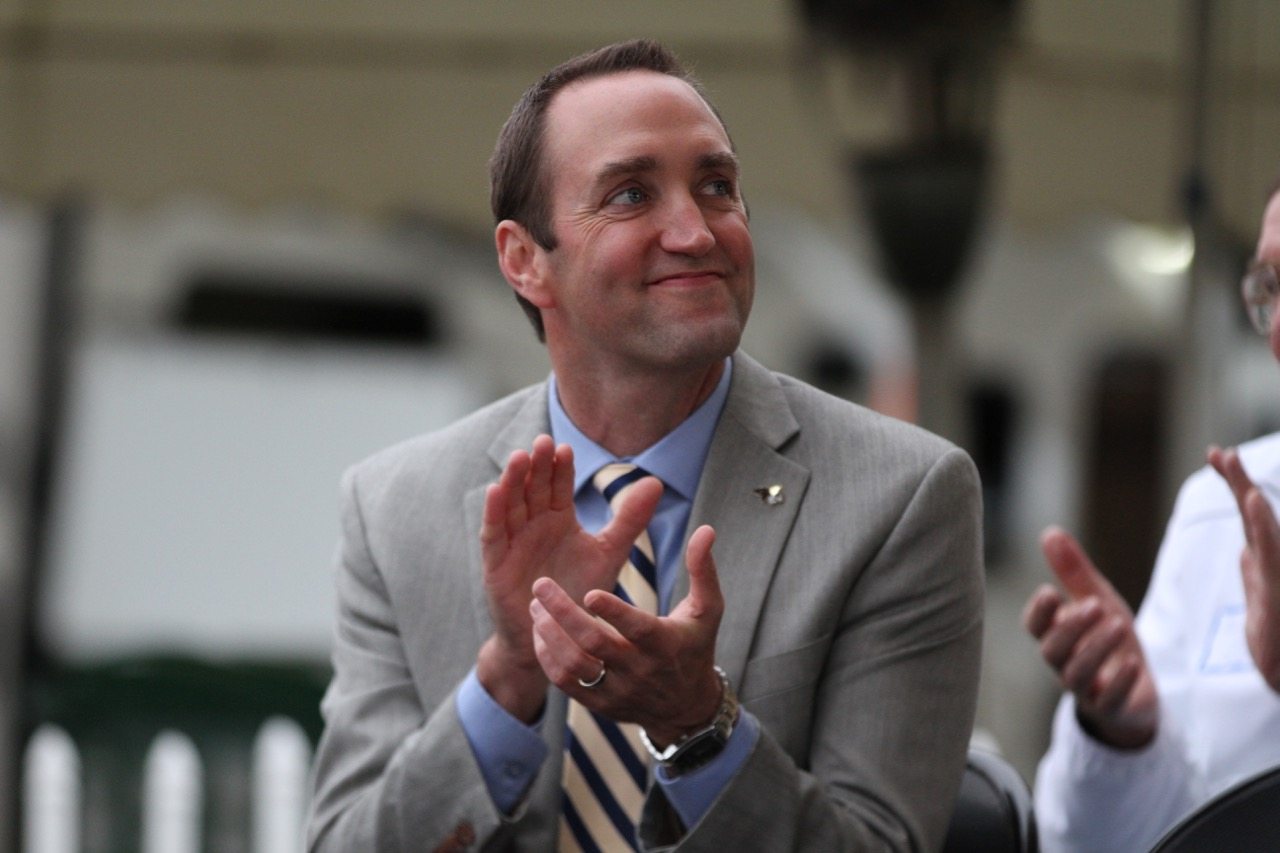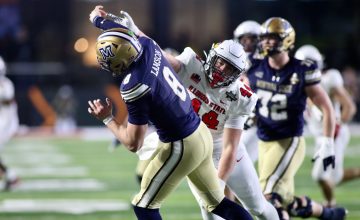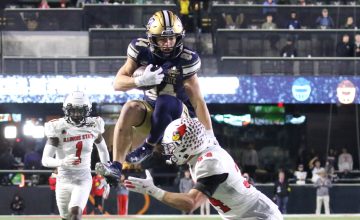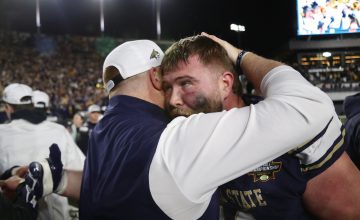Leon Costello begins his second year as Montana State’s athletic director with lofty expectations spurred on by the overall success the campus has experienced so far this decade.
On Friday, Costello presented the next phase of his strategic plan, unveiling “Our Heritage – Our Future”, a road map Costello hopes will guide the Bobcats over the next five years as the athletic department tries to keep pace with one of the thriving universities in the West.
“These are the things we feel we need to do to be competitive right now and in order to recruit and retain the best student-athletes, the best coaches and the best staff,” Costello said in a 30-minute meeting with the local media in Montana State’s Hall of Fame room at Brick Breeden Fieldhouse on Friday morning. “These were the most immediate priorities right now.”
Since Waded Cruzado took over as MSU’s president in 2010, the school has grown from 13,559 students to an anticipated enrollment of more than 16,000 this fall. Montana State has overtaken the rival University of Montana as the state’s largest.
Cruzado made an instant impact, raising $6 million in 90 days as part of a $10 million fundraising effort to build the Sonny Holland end-zone at Bobcat Stadium her first year on the job. On the academic side, she spearheaded a capital campaign that had netted $308 million in donations as of last October.
Cruzado has overseen the renovation of Gaines Hall ($32 million) along with the opening of a $15.7 million Animal Bioscience Building and the remodel of the business school into the sparkling $20 million Jake Jabs College of Business and Entrepreneurship. In 2019, Montana State plans to open the Norm Asbjornson Innovation Center, a $50 million addition to the already nationally recognized College of Engineering.
“I don’t think it’s pressure but I do think what (Cruzado) has done gives us a lot of opportunities, a lot of hope that the things we are trying to accomplish we will be able to get it done,” Costello said. “I think there’s a lot of passion out there for Montana State as a whole and I think we have a lot of impassioned fans for athletics. I think people are sick of waiting and are ready for things to take place. This plan is Step 1.”
Costello said the MSU Athletics’ Facilities Master Plan will be unveiled later this summer.
MSU’s athletic department hasn’t made much of a splash in terms of facility upgrades since the expansion of the football stadium six years ago. In Missoula, Montana opened its $2.5 million academic center in 2015 and is close opening its Champions Center, a 51,000-square-foot facility complete with sparkling locker rooms and a shiny new weight room made possible by $14 million in private donations.
Montana State’s last major athletic facilities upgrade came with the 7,200-seat expansion of Bobcat Stadium before the 2011 season. That $11 million project bowled in the south end-zone of the stadium, added a $1 million scoreboard with a state of the art sound system behind the north end-zone and gave the venue lights. The school completed the installation of new FieldTurf in the football stadium, an upgrade that came with a $625,000 price tag.
Brick Breeden Fieldhouse received a $3.2 million renovation that included a significant upgrade to the facility’s indoor track surface in 2014. Other than that, all the changes for the athletic department have come internally.
The department has seen an overhaul internally, from former athletic director Peter Fields firing Rob Ash after Ash won 70 games and three Big Sky Conference championships in nine seasons to Fields not having his contract renewed by Cruzado less than a year later. Costello has also overseen several internal changes to his senior staff.
Costello took the MSU job last spring and officially started a year ago on July 1. He spent his first 365 days leading MSU athletics by devising a detailed plan. With the help of consulting firm CarrSports, MSU rolled out the next phase of Costello’s vision this week. The leaders identified seven themes intended to “set the course for the department over the next five years,” Costello said.
From a community and statewide relations standpoint, facility upgrades and therefore a massive fundraising campaign will be the most important external part of Costello’s job in the coming years.
“For us, it’s about going out and talking to people and showing people our thoughts,” Costello said when asked if the Montana State fundraising well might be running dry. “It’s matching our vision with what we need to be successful with the donors’ visions. All we can do is try and get this in front of people.
“I think first and foremost, our fans want to see our student-athletes succeed. They want to see them succeed on the field in competition. They want to see them succeed as students and as people. I think they get real enjoyment when they come here, they are here for four or five years, they see them graduate and you see the former athletes come back to campus after they graduate and they’ve become professionals in whatever they are doing. Our fans take pride in that because they got their start here. If they can provide some resources to help that process, I think they will do it.”

Montana State athletic director Leon Costello, pictured here during a football game last season/ by Brooks Nuanez
“Our Heritage – Our Future” is consistent with the university’s strategic plan, Mountains & Minds: Learners and Leaders. The athletic strategic plan “prioritizes the requirements to achieve the department’s vision and mission.” Costello acknowledged that Cruzado has had a big influence on athletics, demanding the department keep pace with the rest of the burgeoning school.
“She’s the driving force,” said Costello, who came to MSU from South Dakota State. “When I was looking at Montana State and this job, I looked at the university strategic plan. That was the one thing I said, ‘We have to have that vision for our sport programs, our coaches, our staff, everyone on the same page. Everyone knows the goals we want to accomplish now and now the public knows that. It gets everyone on the same page. Now how every individual program works to help us achieve is going to be a little bit different. But we all have the same vision now. That all stems from President Cruzado and her executive team.”
The seven-theme plan includes student-athlete well-being and performance; competitive excellence; championship quality facilities; learning and leading; financial responsibility and sustainability; inclusion, diversity and respect; and engagement. Each of the seven themes contains several goals to chart progress and accountability.
Costello’s unveiling began in May with defining Montana State athletics’ core values, including integrity, excellence, respect, engagement, student focus and passion. The department’s vision is defined as:
“Distinguished by the academic success, personal development and life-long achievement of our student-athletes. Admired for our nationally competitive teams. Guided by our values and heritage.”
The mission is defined as: “We purposely contribute to Montana State University’s land grant mission through excellence in the classroom, competition and a holistic approach to student-athlete well-being. Our commitment to integrity, inclusion, respect and service fosters a lasting connection between the MSU community, state of Montana and Rocky Mountain Region.”
MONTANA STATE’S STRATEGIC THEMES
THEME 1: Student-athlete well-being and performance – The University and MSU athletics are committed to providing the resources to support the health, safety, personal development and performance of its student-athletes.
- Foster a culture that values the importance of, and accountability for student-athlete well being.
- Effectively coordinate student-athlete well-being, development and performance services.
- Prioritize student athlete mental health awareness and services.
- Provide student athletes with effective, efficient and cost sensitive health care.
- Provide a comprehensive nutrition program for MSU’s student-athletes.
As Montana State grows and continues to become more competitive, Costello wants to prioritize recruiting the brightest student-athletes to Bozeman. By putting an emphasis on the well being of Montana State’s athletes, Costello hopes to create a culture that young people want to stay a part of.
“Everything we do here has to align with what the university’s goals are and retention is a huge part of what the university is doing as well,” Costello said. “If we can put together programing that retains student-athletes, that helps the university as well.”
THEME 2: Competitive Excellence – MSU Athletics expects to win conference championships and compete for team and individual post-season opportunities. Integrity, sportsmanship and student-athlete development are the cornerstones of our achievements.
- Promote a competitive culture defined by winning championships.
- Provide financial resources to support competitive expectations.
- Provide contemporary competition and practice facilities.
- Attract and retain national caliber coaches and support staff.
- Recruit, retain and graduate accomplished student-athletes.
Montana State’s athletic department is among the most successful in terms of academic achievement and well-rounded accomplishment of any in the Big Sky. Last academic year, Bobcat student-athletes posted a cumulative 3.21 grade-point average. The school remains one of five Carnegie higher research institutions in the Big Sky; Montana, North Dakota, Northern Arizona and Northern Colorado are the others. UC Davis, a football-only affiliate, is the only Big Sky school regarded as a highest research activity institution.
In competition, Bobcat teams have had varying levels of success, from the women’s basketball team punching the program’s first ticket to the NCAA Tournament since 1991 to the volleyball team winning just five matches. The MSU ski teams continued to thrive as head alpine coach Kevin Francis was named the Rocky Mountain Intercollegiate Ski Association Coach of the Year for the third straight winter thanks to MSU’s sixth-place finish nationally. Francis coached Benedict Lynch to an individual national championship in the men’s giant slalom.
In the revenue sports, Montana State’s football season ended on an up note with a victory over the Grizzlies in Missoula to cap an otherwise disappointing 4-7 campaign. The men’s basketball team lost 10 of 11 before the New Year only to win 10 of 12 entering the Big Sky Tournament, where the Bobcats lost in triple overtime to last-place Southern Utah in the first round.
“We want to raise our level of expectation in each sport so that a conference championship is the expectation consistently,” Costello said in May.
THEME 3: Championship Quality Facilities – MSU is committed to athletic facilities that effectively support its student athletes, coaches, staff, university, community and region. Championship quality facilities are foundational to recruiting; achieving competitive excellence, affording an optimal fan experience and growing revenue.
- Develop and implement MSU athletics facilities’ master plan
- Aesthetically improve current MSU athletic facilities
- Establish a long-term financial model for MSU athletics facility projects.
- Explore potential university and community facility partnerships
- Develop an MSU athletics facility renovation, deferred maintenance and technology upgrade plan.
While the operational portions of Costello’s strategic plan are required to “save us time and money in the long run,” he said, the primary demand from the public and the revenue sport head coaches has been for facility upgrades.
From a renovation of the eastside bleachers at Bobcat Stadium to building an indoor football practice facility to upgrading or replacing MSU’s outdated department academic center, the facility needs are in no shortage. It remains to be seen if Costello and his senior staff can secure significant donations like the $7 million gift from the Washington family secured by UM athletic director Kent Haslam to spark Montana’s latest new buildings.
“We will have our facilities master plan coming out in the next few weeks or months, later this summer and that will really get everybody turning because that will identify the major needs that we need from a capital perspective,” Costello said. “This plan identifies what we need operationally.”
THEME 4: Learning and Leading – MSU prepares its student-athletes to graduate equipped with careers and further education by developing the skills to be engaged, informed citizens and leaders of Montana and the world.
- Hold paramount the value of learning, academic success and leadership development.
- Provide resources and services that effectively support MSU athletics’ Learning and Leading
- Seek consistent improvement in student-athlete academic success measurements.
- Offer a comprehensive student-athlete development program that proactively prepares MSU’s student-athletes for life-long achievements.
Camie Bechtold, Montana State’s senior associate athletic director for compliance and student services and the department’s senior woman administrator, has overseen MSU’s improvements in the classroom during her 12 years in the department. During the height of the Mike Kramer football era, Montana State fell into troublesome position academically, resulting in heavy NCAA penalties and, eventually, a restructuring of priorities.
When Bechtold came to MSU in 2005, she estimates less than half of Bobcat student-athletes graduated. Now she says about seven of 10 get degrees in a timely manner, an improved number she’d like to see continue rising.
“We can still get better, we can still graduate our student-athletes at a higher rate,” Bechtold said on Friday.
In 2019, the NCAA will reveal a new benchmark for academic standards. Bechtold said that part of the new requirements will be a GSR (graduation success rate) of 90 percent, an APR of 985 for all sports and a student-athlete graduation rate that is 13 percent higher than that of the students at each institution.
“What we are doing here, we need to dovetail into what the institution is doing as well,” Bechtold said. “We’ve tried to do that significantly with working with people across campus. But that 13 percent higher that we are going to have to strive to achieve, we are doing that right now. As the institution makes strides in their graduation rates, which no doubt will happen here in the next few years, we need to keep challenging ourselves and our student athletes with what’s next. How do we get even better than we already are?”

MSU guard Tyler Hall scored 37 points in front of the first sellout crowd in Bozeman in 15 years against rival Montana in February
THEME 5: Financial Responsibility and Sustainability – MSU athletics demonstrates financial responsibility through practical budgeting, transparency, growth in external revenues and the expansion of strategic partnerships. Financial sustainability will be maintained by continued institutional support, effective fundraising, dynamic corporate relationships, superior custom service and innovation.
- Maintain a comprehensive plan for financial sustainability.
- Enhance effectiveness of MSU athletics’ revenue generating programs and activities.
- Capitalize on university and community partnerships.
- Develop strategies to increase the effectiveness of MSU athletics ticket operations.
- Maximize revenue opportunities and reduce expenses through external vendor relationships.
Costello identified three arms of revenue for his department – ticket sales, fundraising and sponsorships of signage and other advertising opportunities during game days. The key to facility upgrades have almost always been through private donors, both at Montana State and around the country. But Costello sees potential in the other two revenue streams as well.
“There’s still room in football and there’s still room in basketball of course and success is helping that,” Costello said. “Fundraising dollars, Bobcat Club donations…we need to do a better job of reaching out. We have great fans who have supported us for a long time. Now it’s time to take that and go find new people to get involved as well.
“Bozeman is growing, new people are moving to town, new people who may not have any experience with MSU or Bobcat athletics. How do we go out and tap into those people and get them on board? I think we are a great entertainment source. I think we provide something the community can rally behind. We just have to do a better job of reaching out, engaging those people and bringing them into the fold.”
THEME 6: Inclusion, Diversity and Respect — MSU athletics is committed to the values of inclusion, social justice, equity and diversity by fostering an environment that welcomes and respects all student-athletes, staff, opponents and the greater community.
- Promote diverse and inclusive environments and practices that are aligned with university initiatives.
- Maintain an atmosphere that embraces equity and promotes everyones’s contribution to MSU athletics.
- Lead in promoting healthy and safety MSU campus community which embraces people of all identities.
Costello’s hiring of Bethany Cordell as MSU’s associate athletic director for marketing has already paid dividends. Cordell has ramped up the social media and fan engagement efforts across the department, resulting in rising ticket sales for football, men’s and women’s basketball.
“Social media is huge and that’s something our sports information staff have really taken a charge on,” Cordell said. “There’s been a significant impact the last few months from being so much more active on social media.”
Cordell has embraced all the new technologies available in an effort to cater to Bobcat fans across the country while also spreading the department brand.
“I think the idea of streaming games is a great way to build national exposure,” Cordell said. “We are seeing that in the NFL, the NBA, the WNBA, really across the country at the professional as well as the college level. With that piece comes the rights and that’s a piece you have to explore since people do pay for the rights to stream our games.
THEME 7: Engagement – We enrich the university’s connection with the Gallatin Valley community, the state of Montana and the region through our collaboration, communication, service, outreach and an exemplary fan experience.
- Align MSU athletics services and outreach objectives with those of the university the community and the region.
- Maintain meaningful engagement opportunities for MSU’s student-athletes, community and Bobcat fans.
- Coordinate purposeful serve and outreach leadership programs for MSU athletics coaches and staff.
- Develop integrated mutually beneficial media platforms and content.
Costello’s first year on the job at Montana State has been filled with change. To keep pace with the hard-charging president of the university, continued evolution will be required of MSU’s athletic director.
“It’s an exciting time to be a Bobcat and the new strategic plan provides the vision for the future of MSU athletics,” Costello said in a prepared statement. “We have big dreams and goals and this plan is the road map to accomplish each.”
Photos by Brooks Nuanez and attributed. All Rights Reserved.






















